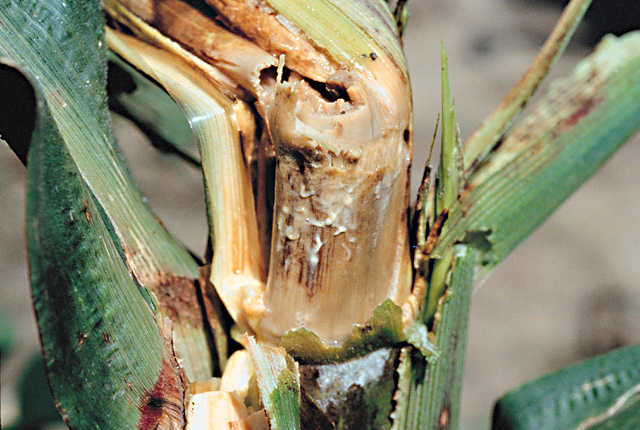Bacterial Stalk rot of maize
C/O: Erwinia carotovora f. sp. zeae
Erwinia chrysanthemi pv. Zeae
Symptoms:
- It shows first premature withering and drying up of the uppermost leaves which was soon followed by the lower leaves.
- The rot either extended from the base upwards (basal rot) or from the top downwards (top rot).
- The host range studies were suggestive of the fact that the maize pathogen, apart from causing the disease on maize, could produce soft rot in potato, carrot, onion, sugarbeet, sweet potato, papaya, cabbage, and many other plants and could also infect Sorghum vulgare, Pennisetum typhoidium, tobacco, and tomato.
- Bacterial stalk rot can affect the plant at any node from the soil surface up to the ear leaves and tassels. Infections that occur high on the plant may impair normal tasseling and affect subsequent pollination.

Basal rot:
- The leaves become yellow and the infected tissue becomes brown, soft, and water soaked. Internally, the stalk turns into a soft mass of disintegrated tissue.
- At this stage the plants usually topple over. A foul odour, accompanied with the presence of dipterous larvae on and in decaying tissues, are the characteristic symptoms of this disease.
- With the advance of the disease the stalk finally dries up into a conglomeration of dry and shredded or disjointed fibrous tissue.
Top rot:
- The top rot begins with wilting and drying up of the tips of middle leaves of the whorl.
- A decay that continues rapidly spreads downwards throughout the stalk and the affected plants soon droop.
- Although it may spread along the plant to infect additional nodes, the bacteria do not usually spread to neighboring plants unless vectored by an insect.
- Splitting the stalk reveals internal discoloration and soft slimy rot mostly initiating at the nodes.
- Because the bacteria usually do not spread from plant to plant, diseased plants are quite often found scattered throughout the field.
Etiology:
- motile, gram-negative, rod shaped bacterium
Favorable condition:
- Favored by high temperatures and high relative humidity.
- Heavy rainfall or where overhead irrigation is used and the water is pumped from a lake, pond, or slow-moving stream.
Survive and spread:
- Survive: overwinters only in the stalk tissue above the soil surface
- Spread: bacteria usually does not spread to neighbouring plants unless vectored by an insect.
Management:
- Avoid excessive irrigation and flooding.
- Avoidance of high rates of nitrogenous fertilizer, high nitrogen applications without phosphorus or potassium resulted in severe disease, but high doses of phosphorus and potassium decreased incidence. Use of resistant varieties e.g. Hybrid Ganga Safed-2, DHM 103 etc.
- Chlorination of irrigation water reduces infection